These 20 breeds offer profitability and quality meat production. From the marbled excellence of Angus to the hardy adaptability of Hereford and the rapid growth of Simmental, you have a range of options. In this blog, we’ll delve into each breed, providing insights to help you make an informed choice for your farm’s success.
How to Select Best Beef Cattle Breeds for Farm
Choosing the best beef cattle breed for your farm revolves around three key factors: ease of calving, carcass quality, and feed efficiency. Notably, “beef cattle” encompasses breeds primarily raised for meat production, a major global industry. It’s vital to recognize that not every bull fits every production scenario due to varying needs and resources. Consider growth rate, feed efficiency, body dimensions, longevity, and carcass quality in your selection process. Additionally, prioritize weather-hardy breeds for regions with extreme temperatures.
20 Best Beef Cattle Breeds
Angus
Angus is a breed of beef cattle that originated in Scotland. They are known for their black or red color, their polled (hornless) trait, and their high-quality meat with fine marbling. Aberdeen Angus is predominantly black, although you can still find red Angus. This breed can resist harsh weather, is adaptable and undemanding, matures early compared to other breeds, and has a high carcass yield. Angus is used to improve carcass quality in other breeds. Angus cattle are adaptable to various climates and have a good temperament. They are one of the most popular beef cattle breeds in the world.
In case you missed it:
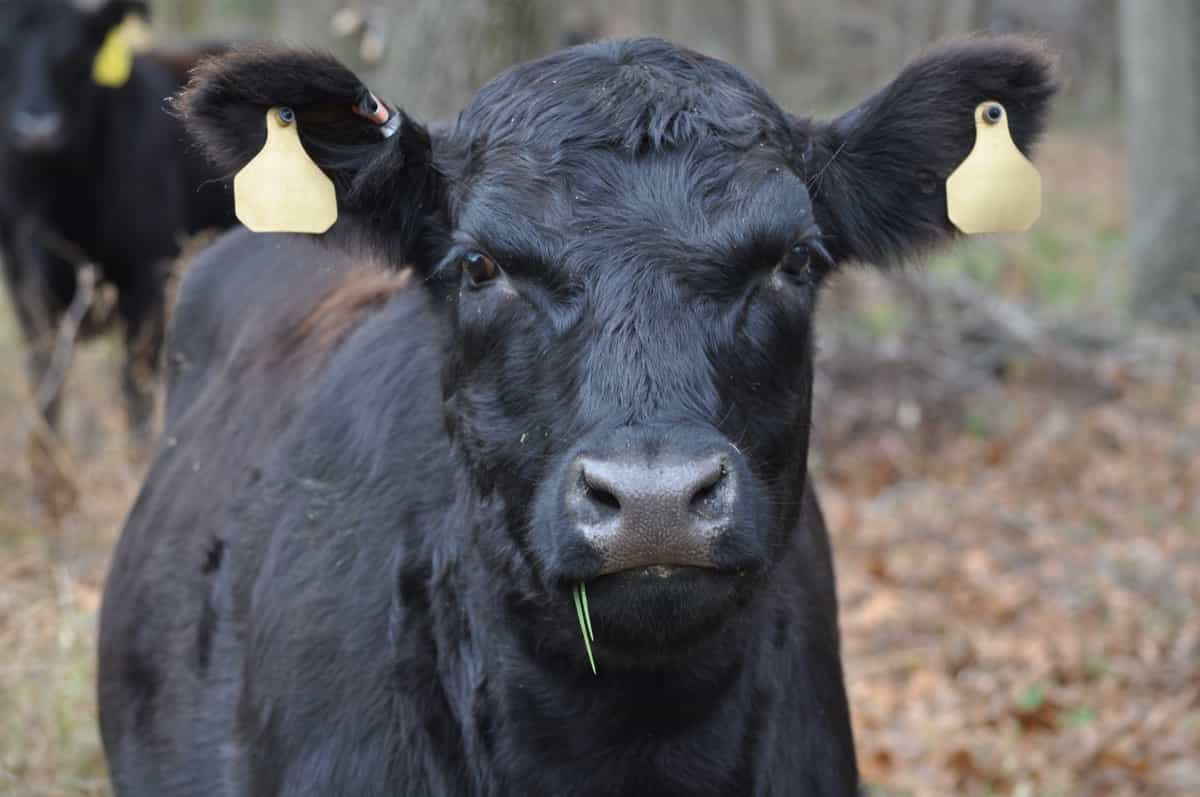
Belted Galloway
The Belted Galloway is a breed of beef cattle from Scotland. It has a white belt around its body, with black, red, or dun color on the rest of its coat. It is adapted to harsh climates and can eat rough vegetation. It produces high-quality marbled beef and sometimes milk. It is also known as Beltie, Oreo Cow, or Panda Cow.
Highland
Highland cattle are a rustic breed of cattle that developed in Scotland’s Highlands and Western Islands. They have large horns and a lengthy, shaggy coat that keeps them warm in cold times. They are hardy, adaptable, and efficient grazers that can thrive on poor-quality pasture. They are also known for their longevity, maternal instinct, and distinctive flavor of their meat. Highland beef is lean, tender, and well-marbled, with lower fat and cholesterol levels than other beef breeds.
Hereford
Hereford cattle are a beef cattle breed originating from Herefordshire, England. They have a distinctive red body with a white face, crest, underline, and legs. They are hardy, muscular, and long-lived animals that are well-adapted to different climates and environments. They are one of the world’s most popular beef breeds, with over five million purebred Hereford cattle in over 50 countries.
In case you missed it: Lumpy Skin Disease in Cattle: Causes, Symptoms, Treatment, and Control
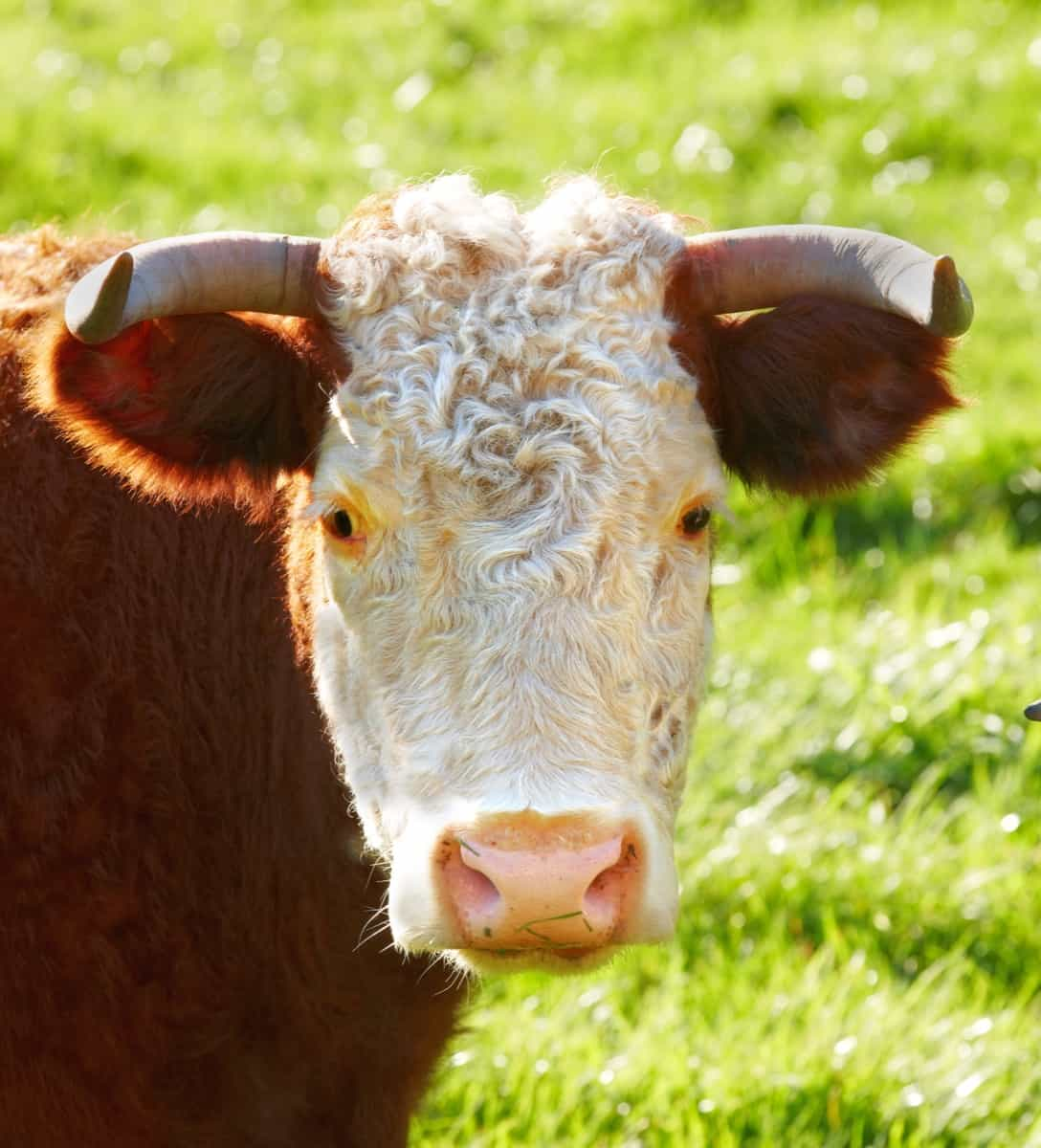
Texas Longhorn
The Texas Longhorn is an American beef cattle breed distinguished by its large horns, which can reach more than 8 feet (2.4 meters) from tip to tip. It is derived from cattle brought to the Americas by Spanish conquistadors from the Iberian Peninsula between the period of Christopher Columbus’ Second Voyage and 1512.
The Texas Longhorn is adapted to harsh conditions and can thrive on marginal pastures. It is also resistant to many common bovine diseases. The Texas Longhorn can be of any color or mix of colors, but red is the most common shade. The Texas Longhorn is considered part of the cultural heritage of Texas and is the mascot of The University of Texas at Austin.
Murray Grey
Murray Grey is a breed of Australian polled beef cattle originating from a cross between an Aberdeen Angus bull and a Shorthorn cow in 1905. They have a grey, silver, or dun coat color with dark skin pigmentation that protects them from sunburn and eye cancer. They are moderate in size, with bulls weighing 780–860 kg and cows weighing 500–680 kg.
They are known for their easy calving, good milking, fast growth, feed efficiency, and high-quality marbled beef. They are adaptable to various climates and have performed well in heat-stress trials. They are popular in Australia and have been exported to other countries such as Canada, New Zealand, the United Kingdom, and the United States.
Simmental
Simmental is a Swiss breed of cattle that is raised for both milk and meat. They have a reddish color with white markings and a white head with pigmented eyes. They are large, muscular, and well-adapted to different environments. Simmental cattle are known for their high milk yield, fast growth rate, and good meat quality. They are one of the oldest and most widely distributed cattle breeds in the world.
In case you missed it: How to Make Corn Silage: Production and Management Steps for Goats, Sheep, Cows, Pigs, and Cattle
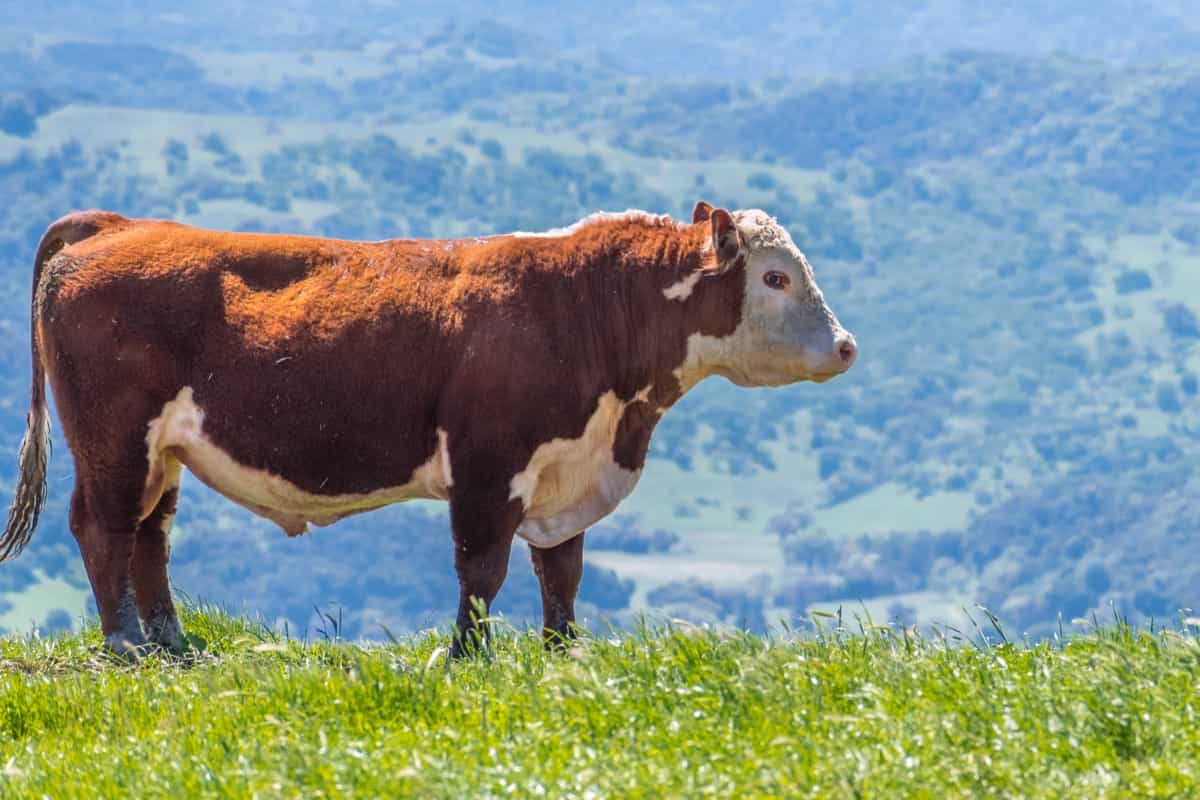
Maine-Anjou
The Maine-Anjou is a large breed of beef cattle that originated in France. It was created by crossing the local Mancelle dairy cattle with Durham cattle from Britain. The breed has a distinctive red and white coat, with a redhead and eyes surrounded by red. The Maine-Anjou is known for its hardiness, docility, and ease of handling.
It can produce high-quality beef with good marbling and tenderness. The average weight of a Maine-Anjou bull is 1000 to 1500 kg, while a cow weighs 850 to 1000 kg. The breed is popular among small farmers and young breeders in America, where it competes in various cattle shows and exhibitions.
Salers
Salers cattle are a French breed that originated in the Auvergne region of the Massif Central. They are mahogany red or black, with long, light-coloured horns. They are hardy, fertile, and adaptable to harsh climates. They produce rich milk for cheese making and high-quality beef. They have a large pelvic area and a short gestation period, which makes calving easy. They are calm, intelligent animals that can forage on native grasses and hay.
Piedmontese
Piedmontese beef cattle are a breed of domestic cattle that originate in the region of Piedmont in northwest Italy. They have a unique gene mutation that causes double muscling, which means they have more lean muscle and less fat than other breeds. Piedmontese cattle are usually white or light grey, with black skin and horns.
They are medium-sized, with fine bones and broad shoulders. The average weight of a Piedmontese cow is 520-550 kg, and of a bull is 700-850 kg. Piedmontese cattle are known for their calving ease, docility, fertility, and longevity. Piedmontese beef is considered a premium product, as it is tender, juicy, and low in cholesterol.
Chianina
The Chianina is a large white cattle breed from Italy, mainly raised for beef production. It is one of the oldest and largest cattle breeds in the world, with bulls weighing up to 1500 kg and cows up to 1000 kg. The Chianina has black skin, a black tongue, a black switch, and short horns that curve forward. The Chianina is well adapted to warm climates and resistant to parasites and diseases. Chianina produces high-quality lean meat with good marbling and tenderness. The bistecca alla fiorentina, a traditional steak dish from Tuscany, is made from Chianina meat.
Charolais
The Charolais cattle breed is a big, light-colored draft breed established in France. They are utilized for beef production as well as crossbreeding to improve the growth and muscle mass of other beef cattle breeds. These cattle are known for their cream or white coloring, horns, and massive size. They are among the heaviest cattle breeds, with bulls weighing 1000-1650 kg and cows weighing 700-1200 kg. They have a pale pink nose and hooves, making them less affected by sun and heat. They have better longevity and growth potential than other beef cattle breeds.
In case you missed it: Top and Highest Milk Producing Cattle/Cow Breeds in India: Best Guide for Beginners
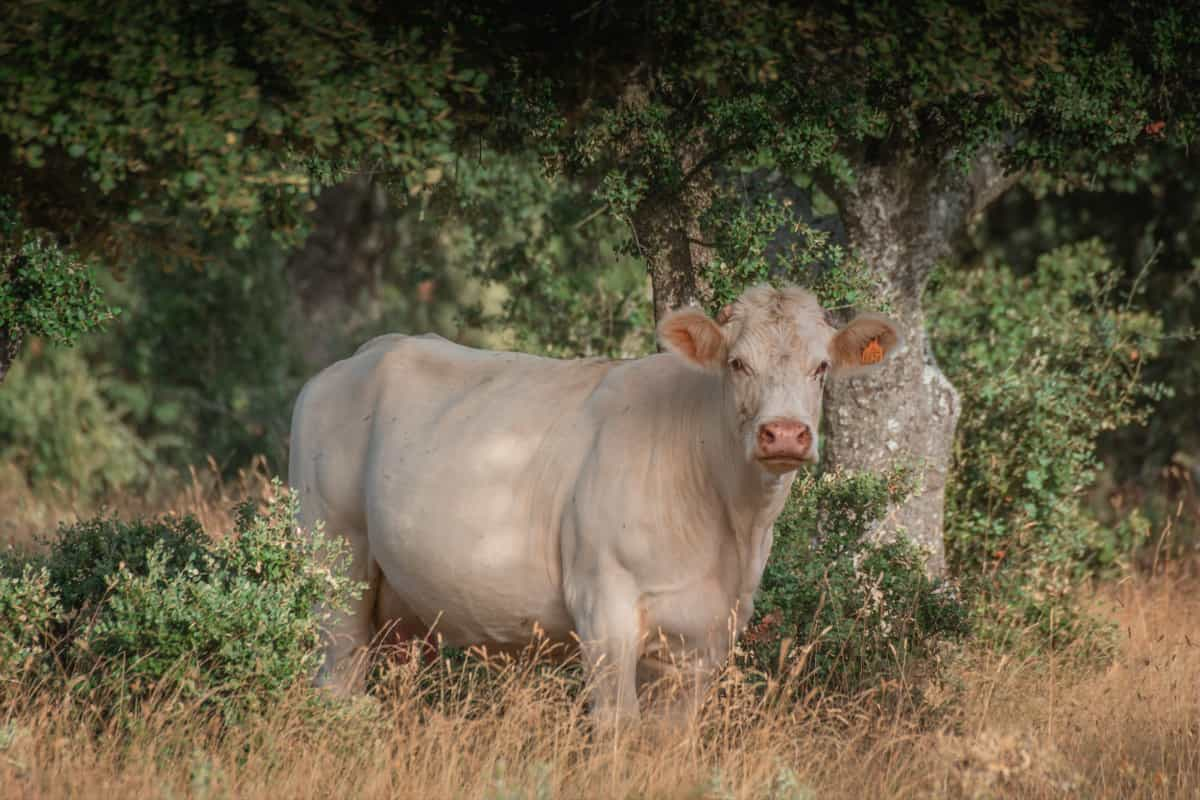
Limousin
Limousin is a French breed of beef cattle that originated from the Limousin and Marche regions of France. It was formerly used as a draught animal, but now it is mainly reared for beef production. Limousin cattle are known for their high muscling, low fat, and good saleable meat yield. They have a bright wheat-colored coat, a strong-boned frame, and horns that curve forward and upwards. Limousin cattle are adaptable to different climates and environments, and they are also used for crossbreeding with other cattle breeds to improve their meat quality and performance.
Gelbvieh
Gelbvieh is a cattle breed that originated in Germany and is mainly used for beef production. Gelbvieh cattle have a reddish-yellow to black coat with strong pigmentation and are sometimes polled. They are known for their high growth rate, feed efficiency, manageability, and longevity. Gelbvieh cows are also very maternal, with early puberty, good milk production, and easy calving. Gelbvieh cattle can adapt to different climates and environments.
Beefmaster
The Beefmaster breed, developed in the 1930s by Tom Lasater, combines the best attributes of Hereford, Milking Shorthorn, and Brahman cattle. Their resistance to drought, heat, and insects, coupled with a light-to-dark red coloration, makes them adaptable and hardy. Notably, Beefmasters boast high growth rates, excellent maternal instincts, and efficient feed-to-meat conversion. This dual-purpose breed suits both large-scale commercial operations and small-scale farms, offering versatility and robust performance. With a lineage comprising approximately 25% Hereford, 25% Milking Shorthorn, and 50% Brahman, the Beefmaster, at times referred to as Brahman Beefmaster, showcases the strength of crossbreeding for superior cattle traits.
Shorthorn
Shorthorn is a dual-purpose breed of cattle that originated in England in the 18th century. The Beef Shorthorn is a variation that was developed for its meat quality and performance. Beef Shorthorns are red, white, or roan in color and have a medium to large frame. They are docile, hardy, and adaptable to different climates and environments. They produce tender, marbled, and flavorful beef that consumers highly value. Beef Shorthorns are also good mothers, easy calvers, and efficient feed converters. They are often used in crossbreeding programs to improve the traits of other breeds.
Brahman
Brahman is a breed of beef cattle that originated from India and was developed in the United States from different strains of Bos indicus cattle. Brahman cattle have a distinctive hump over their shoulders, a large dewlap, drooping ears, and horns that curve upwards. They are usually light to medium grey or red but can also be black, brown, or white. Brahman cattle are adapted to tropical and subtropical climates, as they have thick skin, short hair, and black pigmentation that protect them from heat, insects, and diseases.
In case you missed it: Top Cattle Feed Manufacturers in India: Companies List
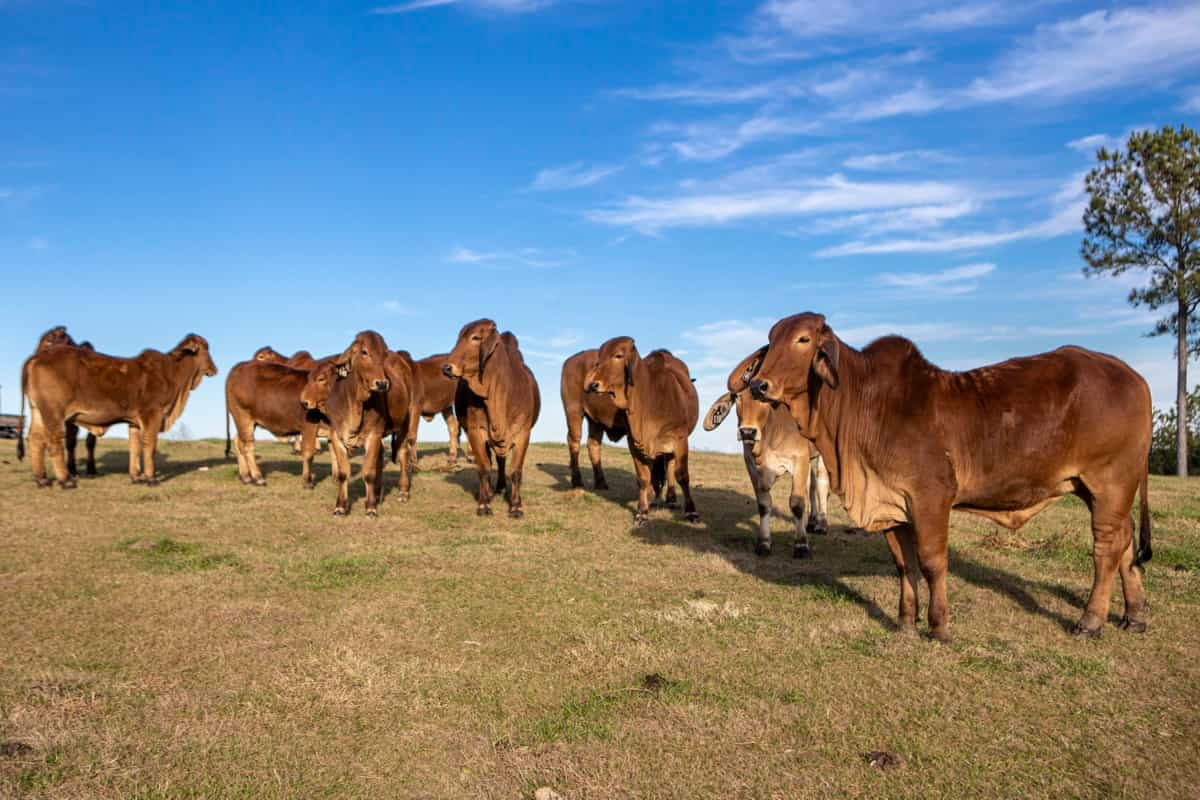
They are also known for their longevity, fertility, and resistance to drought and parasites. Brahman cattle are used for meat, milk, and draught purposes and have been crossed with other breeds to create many synthetic breeds such as Brangus, Braford, Simbrah, and Beefmaster. Brahman cattle are medium to large, with mature bulls weighing 800-1100 kg and mature cows weighing 500-700 kg.
Santa Gertrudis
The Santa Gertrudis is an American breed of beef cattle that originated in Texas in the early 20th century. It is a hybrid of Brahman and Shorthorn cattle, which gives it a red coat, a large body, and a high tolerance to heat and humidity. The Santa Gertrudis is mainly used for beef production, as it has a good growth rate, a high dressing percentage, and tender and flavorful meat. The average weight of a bull is 750–1000 kg, while a mature cow weighs 600–850 kg. The breed is also known for its longevity and fertility, as it can reproduce until late.
Aubrac
The Aubrac beef breed hails from Southern France, specifically the Plateau de l’Aubrac Massif. These cattle, weighing from 2000 to 2600 pounds, exhibit a distinctive wheat-colored coat in various shades. Notably, their shoulders and croup feature dark-colored skin. Aubrac cattle are of medium build, characterized by robust musculature, making them well-suited for various agricultural tasks. Their adaptability to the rugged terrain of the Aubrac Massif, combined with their sturdiness, has earned them recognition and utility in traditional and modern farming practices.
Brangus
Brangus cattle are a hybrid breed of beef cattle that originated from crossing Angus and Brahman cattle. They have 5/8 Angus and 3/8 Brahman genetics, which gives them the advantages of both parent breeds. Brangus cattle are black or red, polled, and have a sleek coat and pigmented skin.
In case you missed it: Dairy Disease Symptoms and Treatment for Cows, Cattle, Goats, and Sheep

They are resistant to heat, humidity, and diseases and have good temperament, fertility, and milking ability. Brangus cattle also produce high-quality beef with superior carcass traits. The average weight of mature Brangus bulls is between 1,800 and 2,000 pounds, while mature cows weigh around 1,100 to 1,200 pounds.
Comparison of Best Beef Cattle Breeds for Your Farm
| Breed | Origin | Milk Production | Price (per cow) |
| Angus | Scotland | Low | $1,200 – $2,500 |
| Hereford | England | Low | $900 – $2,500 |
| Simmental | Switzerland | High | $1,500 – $2,500 |
| Charolais | France | Low | $1,000 – $3,000 |
| Limousin | France | Low | $900 – $2,500 |
| Gelbvieh | Germany | High | $1,200 – $2,500 |
| Red Angus | Scotland/USA | Low | $1,200 – $2,500 |
| Shorthorn | England | Medium-High | $900 – $2,500 |
| Brahman | India | Low | $900 – $2,500 |
| Brangus | — | Low-Medium | $900 – $2,500 |
| Santa Gertrudis | — | Low-Medium | $900 – $2,500 |
| Beefmaster | USA/Brazil/Australia/ | Medium-High | $900 – $2,500 |
| Salers | France | High | $1,200 – $2,500 |
| Maine-Anjou | France | Medium-High | $1,200 – $2,500 |
| Chianina | Italy | Low-Medium | $1,200 – $2,500 |
Conclusion
Selecting the right beef cattle breed for your farm is vital. Factors like adaptability, meat quality, and disease resistance play a crucial role. Choose wisely based on your farm’s specific needs for profitability and success.
- Types of Pesticides Used in Agriculture: A Beginner’s Guide
- Economical Aquaculture: A Guide to Low-Budget Fish Farming
- 15 Common Planting Errors That Can Doom Your Fruit Trees
- How to Make Houseplants Bushy: Effective Tips and Ideas
- Innovative Strategies for Boosting Coconut Pollination and Yield
- Pollination Strategies for Maximum Pumpkin Yield
- The Complete Guide to Chicken Fattening: Strategies for Maximum Growth
- Natural Solutions for Tulip Problems: 100% Effective Remedies for Leaf and Bulb-Related Issues
- Revolutionizing Citrus Preservation: Towards a Healthier, Greener Future
- Natural Solutions for Peony Leaf and Flower Problems: 100% Effective Remedies
- Maximizing Profits with Avocado Contract Farming in India: A Comprehensive Guide
- Natural Solutions for Hydrangea Problems: 100% Effective Remedies for Leaf and Flowers
- The Ultimate Guide to Choosing the Perfect Foliage Friend: Bringing Life Indoors
- From Sunlight to Sustainability: 15 Ways to Use Solar Technology in Agriculture
- The Ultimate Guide to Dong Tao Chicken: Exploring from History to Raising
- The Eco-Friendly Makeover: How to Convert Your Unused Swimming Pool into a Fish Pond
- Mastering the Art of Delaware Chicken Farming: Essentials for Healthy Backyard Flocks
- 20 Best Homemade Fertilizers for Money Plant: DIY Recipes and Application Methods
- How to Craft a Comprehensive Free-Range Chicken Farming Business Plan
- Brighten Your Flock: Raising Easter Egger Chickens for Beauty and Bounty
- How to Optimize Your Poultry Egg Farm Business Plan with These Strategies
- Subsidy for Spirulina Cultivation: How Indian Government Schemes Encouraging Spirulina Farmers
- Ultimate Guide to Raising Dominique Chickens: Breeding, Feeding, Egg-Production, and Care
- Mastering the Art of Raising Jersey Giant Chickens: Care, Feeding, and More
- Ultimate Guide to Raising Legbar Chickens: Breeding, Farming Practices, Diet, Egg-Production
- How to Raise Welsummer Chickens: A Comprehensive Guide for Beginners
- How to Protect Indoor Plants in Winter: A Comprehensive Guide
- Ultimate Guide to Grow Bag Gardening: Tips, Tricks, and Planting Ideas for Urban Gardeners
- Guide to Lotus Cultivation: How to Propagate, Plant, Grow, Care, Cost, and Profit
- Agriculture Drone Subsidy Scheme: Government Kisan Subsidy, License, and How to Apply Online
- Ultimate Guide to Raising Araucana Chickens: Breed Profile, Farming Economics, Diet, and Care
- Bringing Hydroponics to Classroom: Importance, Benefits of Learning for School Students
- Ultimate Guide to Raising Polish Chickens: Breed Profile, Farming Economics, Diet, and Care
- Ultimate Guide to Raising Australorp Chickens: Profile, Farming Economics, Egg Production, Diet, and Care
- Silkie Chicken Farming: Raising Practices, Varieties, Egg Production, Diet, and Care
- Sussex Chicken Farming: Raising Practices, Varieties, Egg Production, Diet and Care
I need to start my career in farming
Good information